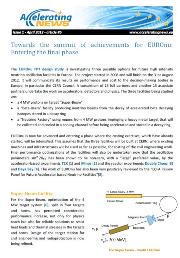![]() EUROnu: proposing future neutrino facilities at CERN
EUROnu: proposing future neutrino facilities at CERN

Comparison of error in delta measurement in the different neutrino facilities. Image credit: EUROnu
The EUROnu project studied three different “next generation” facilities that could be located at CERN. The final results and conclusions were delivered at the end of August 2012 after 4 years of prosperous work. The studies included the accelerators, the detectors and the physics performance and cost of the complete facilities.
Two studied facilities, the Super-Beam (SB) and the Beta-Beam (BB), are designed to send neutrino beams to a future Water Cherenkov detector located in the Fréjus tunnel, 130 km from CERN. Due to the short baseline, these two facilities have good sensitivity to the CP violation process. The SB can also, with great benefit for the physics reach, deliver a beam to a longer baseline (use of the second oscillation maximum), where the CP reach is good but also some access to the mass hierarchy is possible. The third facility studied in the EUROnu project, the Neutrino Factory (NF), would use a Magnetized Iron Neutrino Detector (MIND) located at more than 2000 km from CERN. This facility would have the best physics reach, able to determine both the neutrino mass hierarchy (the spectral order of neutrinos) and to study CP violation. In addition it would have the best potential to detect evidence of “new physics”.
![]() A European strategy for accelerator-based neutrino physics
A European strategy for accelerator-based neutrino physics


Fig1: CERN to Pyhäsalmi baseline, 2300 km. Image credit: LARP
Fig2: Preliminary layout of a 10 GeV Neutrino Factory on the CERN site, with neutrino beams pointing at Pyhäsalmi.
In preparation for the CERN strategy meeting in Cracow NEu2012 as part of EuCARD project activities has delivered a coherent proposal for the next accelerator neutrino facility in Europe, as a result of two complementary design studies. The programme calls for the continuation of neutrino beams at CERN after the CNGS, and for a high priority support from CERN and the member states to the experiments and R&D programme.
Since the 2006 European Strategy for Particle Physics (ESPP), the experimental situation has evolved; the next step is the quantitative evaluation of the measurement of the mass hierarchy and of the CP violation. Following the 2006 ESPP recommendations, two complementary design studies have been carried out by LAGUNA/LNBO and EUROnu. The role of EuCARD’s NEu2012 project activity has been to foster convergence between these different communities.
LAGUNA LBNO recommends a conventional neutrino beam CN2PY from CERN SPS towards the Pyhäsalmi mine in Finland situated at 2285 km, with a Liquid Argon magnetized iron hybrid detector. An expression of interest with large community support has been submitted, and aims at a full proposal by 2014.
EUROnu has compared a conventional super-beam from the CERN HP-SPL, a beta-beam implemented on the CERN site, and a Neutrino Factory. It concluded that a 10 GeV Neutrino Factory, aimed at a magnetized neutrino detector situated, also, at the same baseline of around 2200 km (±30%), would constitute the ultimate neutrino facility. It recommends that the next 5 years be devoted to the R&D, preparatory experiments and implementation study, in view of a proposal before the next ESPP update.
Poster for the second meeting on the European Strategy for Neutrino Oscillation Physics (click image to enlarge) Image credit: Neutrino Town Meeting
The second meeting on the European Strategy for Neutrino Oscillation Physics was held the 14-16 May 2012 at CERN, attracting some 150 registrants, from European institutes and beyond.
The goal of the meeting was to collect necessary input from the neutrino oscillation community and prepare a proposal to the Preparatory Group of the European Strategy Group. The consensus of the community should be expressed in this proposal, with a medium- and long-term road map for the accelerator based neutrino oscillation physics facilities in Europe.
The meeting concluded by stressing again the great discovery potential of the physics of massive neutrinos: it raises new questions that have no unique answer in the Standard Model of particle physics, and calls for a high priority programme in Europe. One of the highest prizes, leptonic CP violation, requires accelerator-born neutrino beams. Proposals for a middle and long-term accelerator-based programme were formulated and discussed critically, stressing the importance of a sustained R&D towards the ultimate accelerator and detector facilities, and the synergy with astro-particle physics.
The written proposal for the European Strategy Group will be worked on and presented at the Preparatory Strategy Meeting in Krakow (10-12 September 2012).In addition, Alain Blondel presented Beams for Neutrino Physics: a coherent proposal? in the EuCARD annual meeting. A full report of the Neutrino Town Meeting is available below.
|
Image of the full EUROnu article, available here. Image credit: Accelerating News The EUROnu FP7 design study is investigating three possible options for future high intensity neutrino oscillation facilities in Europe. The project started in 2008 and will finish on the 31st August 2012. It will communicate its results on performance and cost to the decision-making bodies in Europe, in particular the CERN Council. A consortium of 15 full partners and another 15 associate partners undertake the work on accelerators, detectors and physics. The three facilities being studied are: a 4 MW protons on target “Super-Beam”; a “Beta-Beam” facility producing neutrino beams from the decay of accelerated beta decaying isotopes stored in a decay ring; a “Neutrino Factory” using muons from 4 MW protons impinging a heavy metal target that will be collected and cooled in a cooling channel before being accelerated and stored in a decay ring. EUROnu is now far advanced and entering a phase where the costing exercises, which have already started, will be intensified. This assumes that the three facilities will be built at CERN, where existing machines and infrastructures will be used as far as possible, for costing of the civil engineering work. |


